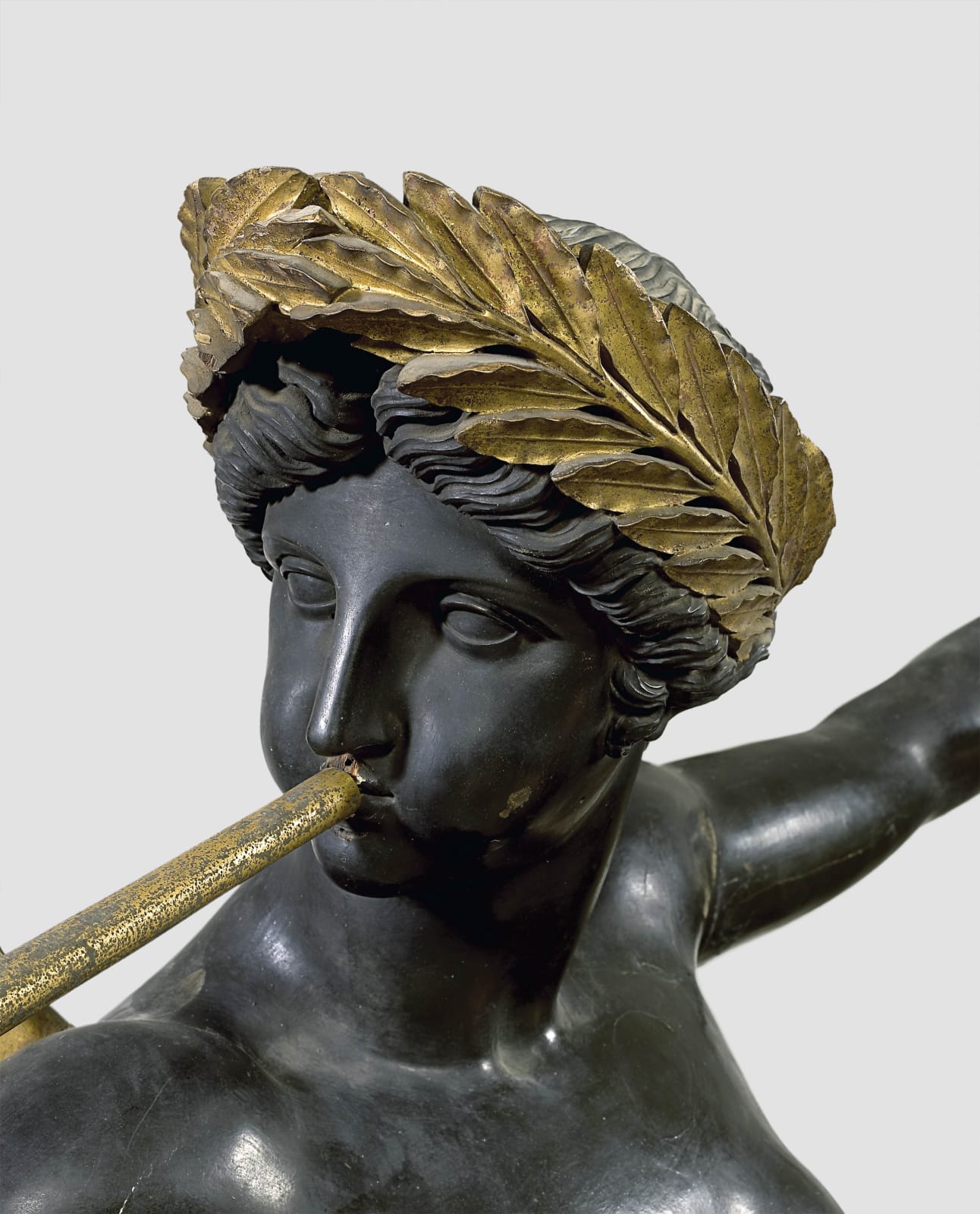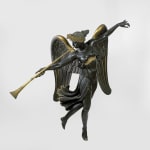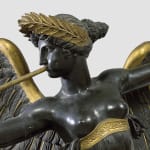Pierre-Louis-Arnulphe Duguers de Montrosier (after)
Further images
Provenance
Galerie Geraldi, Faubourg Saint-Honoré, Paris, June 1948. Purchased by Professor Guy Ledoux-Lebard, Paris.
Exhibitions
"Chefs-d'Oeuvre des Grands Ebénistes", Musée des Arts Décoratifs, Paris, 1951, no. 50.
Literature
Denise Ledoux-Lebard, "Le Mobilier Français du XIXe Siècle", 2000, p. 175, illustrating this statue.
A very rare Empire gilt and patinated carved wood winged statue in imitation of bronze, representing Fame after a design by Pierre-Louis-Arnulphe Duguers de Montrosier, the beautiful female figure in flight, wearing a diaphanous skirt gathered under her bare breasts, her coiled hair caught in a bun and adorned by a crown of palms, with arms outstretched she plays a gilt bronze trumpet held in her right hand
Paris, date 1805
Height 148 cm, width 168 cm.
This superb statue of Fame (Renommée) was created from a design by Pierre-Louis-Arnulphe Duguers de Montrosier (1758-1806) and was reproduced in his "Recueil de dessins de meuble, pendules et candélabres composés (…) à l'occasion de l'Exposition des Produits de l'Industrie Française", 1806, pl. V, (Bibliothèque Marmottan, reproduced ibid, p. 174). The sheet from his "Recueil" shows Fame drawing back a curtain to reveal a pair of bronze Roman soldiers flanking a marble console upon which is a military trophy featuring the same figure of Fame on an oval plaque. His catalogue described it in greater detail as "Fame, a figure of perfect proportions, who lifts a richly gilt tasselled curtain to reveal a star-studded cloth on which features the figure of immortality destined to adorn the hero's armour which has always been crowned by Victory. Fame sounds at all hours and at will fanfares, which imitate the sounds of a real trumpet. These fanfares announce the chiming of the hours and the movement of the shield reveals the armorial trophy; immediately afterwards the mechanism plays one of four musical pieces."
Duguers de Montrosier's stand at the Exposition of 1806 included a number of other extraordinary pieces including a clock depicting a monument to the glory of Frederic the Great upon a console supported by fasces (both now in the Mobilier National, Paris) as well as an octagonal table, decorated with the arms of Joséphine and featuring six floral posies, a vase of flowers and a crystal bowl for rare fish, all surmounted by a cage containing mechanical birds. The two bronze Roman soldiers attributed to Duguers de Montrosier, after his design for Renommée, were sold by Christie's London, 31st May 1978, lot 106.
Born at Landau in the French Palatinate, Duguers de Montrosier was expected to achieve a glittering military career like his father. At sixteen he was made a sub-lieutenant but in 1779 he left the army. During the Revolution he was installed at Neuilly-sur-Seine; then in 1799 he and his wife Anne-Elisabeth née Lair, daughter of one of Louis XVIII's maréchals de camp, borrowed 25,000 francs from Henrion. This was probably to finance his new venture as an ébéniste since soon after this he went into association with Hutin a marchand-ébéniste of 2 boulevard des Italiens and began making extraordinary pieces both in conception and in execution. However his new career was cut short by his early death in 1806.
His business was continued by his widow who immediately tried to free herself from repaying a government loan of 100,000 francs. Therefore she saw through the completion of many pieces designed by her husband, illustrated in his "Recueil de Dessins" and tried without success to sell them to the Napoleon who found them too complicated for his taste. The only way she was able to evade the repayment was to leave the entire collection to the Garde-Meuble. The Emperor eventually accepted the following pieces: A monument clock composed as a console crowned with a marble group of figures; a large mirror featuring Psyche dominated by a bow; a gilt bronze mounted walnut secrétaire containing a clock and organ; a pair of bronze twelve-light candelabra supported on girandoles; the Frederic the Great clock as well as other unusual clocks, a variety of consoles, a table and other ornate candelabra.
Provenance can add greatly to the importance of a work of art especially when a past owner was as great a connoisseur as Professor Guy Ledoux-Lebard (b. 1910). A leading figure in the world of medical radiology Professor Ledoux-Lebard did not wait until the end of his career to pursue his love of art. His artistic taste, with its enthusiasm and attention to detail, reflected the scientific rigor of his professional training so that he and his wife came to acquire some of the very finest works of art and predominantly those from the Empire period. He was born in Paris, close to the Arc de Triomphe in the 8th arrondissement in the family apartment where he remained all his life. His family had a strong medical background, for instance his grandfather Auguste, who was close to Antoine Béclère and Georges Haret, the pioneer of medical radiology, was the first French doctor to teach clinical radiology. Whilst still at boarding school (1934-38) Guy Ledoux-Lebard developed an interest in electro-radiology. During his last year at school he worked at the Hôpital Hérold with Professor Robert Debré, who created paediatric medicine to cover all disciplines and especially radio-diagnosis. He himself qualified as a professor in 1958 while acting as assistant to Professor Henri Desgrez, head of medical radiology. Among his numerous medical achievements Ledoux-Lebard made breakthroughs in the study of osteoarticular radiology and Paget's disease.
It was with this approach that he regarded the art of collecting. As he affirmed, "Whether one is producing a radiological diagnosis or assessing a fine Napoleonic object, the intellectual approach is identical." His father was also an enlightened collector, who acquired Queen Hortense's jewellery casket and the ensemble of chamber pots, bedpans as well as other furniture and works of art. It was in his memory that Guy Ledoux-Lebard and his wife presented the Malmaison with a small patinated bronze version of an Egyptian temple made to the designs of Vivant Denon that originally stood in the Château library. His contributions to art also include articles in periodicals such as "Bulletin de la Société d'Histoire de l'Art Français" or the "Revue de l'Institut Napoléon", as well as books notably "Napoléon Portraits Contemporains, Bustes et Statues", which he wrote in collaboration with Gérard Hubert.
Professor Ledoux-Lebard always enjoyed a close relationship with the museum world. At times he donated in memory of his father, for instance in 1990 he and his wife offered the Malmaison & Bois-Préau a patinated and gilt bronze model of the Temple of Denderah, which was originally housed in the library of the Empress Joséphine and was mentioned in her estate inventory. A few years later he donated a pair of bedside tables and a secrétaire by Jacob Frères of circa 1799, which came from Madame Juliette Récamier's bedroom (illustrated in the album by Krafft and Ransonnette).





